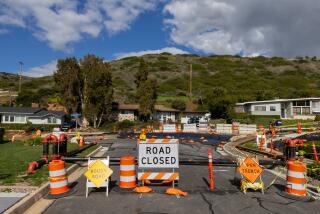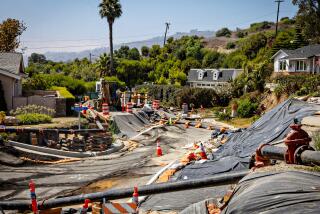Rupture Feared in Event of Flood : Fuel Pipeline Has San Juan Officials Worried
SAN JUAN CAPISTRANO — Officials here fear that a $20-million fuel pipeline, built without their knowledge, might break in a major flood and permanently contaminate the ground-water supply.
The pipeline, built and operated by the San Diego Pipeline Co., a public utility, stretches from Los Angeles to San Diego. It meanders through eastern Orange County and crosses onto a sliver of San Juan Capistrano and under San Juan Creek at a point where landfill along the creek bank has washed out in heavy storms, according to Bill Murphy, San Juan Capistrano director of public works. A major flood could wash out the landfill again, Murphy said, leaving the pipeline--buried 10 feet under the creek but only three feet under the adjacent landfill--dangerously exposed.
A rupture in the line could spill liquid fuel into the creek and eventually into the aquifer that supplies the Capistrano Valley with about 25% of its water, Jim Mocalis, Capistrano Valley Water District general manager, said.
“It’s our most valuable resource; it’s the second largest aquifer in all of Orange County,” Mocalis said. “We would have to pump the whole aquifer dry, which could take years. We may never be able to do it.”
Murphy recently contacted the pipeline company and asked that it produce engineering data demonstrating that the pipe could withstand a major flood. “They owe it to the community to show that the fuel pipe was constructed in a safe manner,” Murphy said. “So far, I haven’t received a satisfactory response.”
San Diego Pipeline Co. special projects manager Joseph A. Whitelaw, however, said the pipeline was properly constructed and contained safeguards to prevent a damaging fuel spill. The pipeline is electronically monitored for leaks around the clock, Whitelaw said, and valves on either side of the creek channel would be closed if the line was in danger, shutting off the flow.
Nevertheless, the company will have a hydrologist perform an erosion study on the creek bank to satisfy local officials, and, if necessary, will re-dig part of the pipeline, Whitelaw said Tuesday.
Ironically, the local authorities would not have known that the pipeline was being built if engineers had not deviated from the planned route on unincorporated Rancho Mission Viejo land and wound up on San Juan Capistrano farmer Jean Lacouague’s orange grove.
Lacouague, who first found out about the project when his son spotted a bulldozer clearing a right of way near the edge of his property, did not argue with the pipeline company’s right to condemn a strip of his land for public use. But he had seen floods ravage that corner of his land, taking out rows of eucalyptus trees and carrying away tons of dirt, he said, so when he heard that the pipeline was only being buried three feet under the landfill, he took his concerns to Murphy and to the water board.
That was the first they had heard about the project, said T.J. Meadows, who as general manager of the San Juan Basin Authority, a joint powers agency for three local water districts, was amazed that the local authorities had never been contacted during the environmental review process. “It’s just unheard of in this day and age for anything of that magnitude to go in without that (consultation). We certainly did not know about it. I’m shocked.”
San Juan Capistrano and its water districts were not contacted because no negative impact there was foreseen, said Michael Evans, senior environmental planner for San Diego County, which was responsible for contacting affected parties.
The 16-inch, welded steel pipeline, of high tensile strength, eventually will replace a 10-inch pipeline that follows a parallel route. It will serve industrial and military customers in Los Angeles, Orange and San Diego counties.
More to Read
Sign up for Essential California
The most important California stories and recommendations in your inbox every morning.
You may occasionally receive promotional content from the Los Angeles Times.









